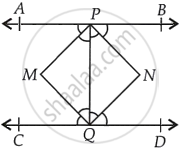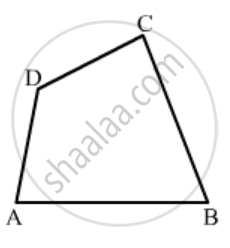Advertisements
Advertisements
Question
If APB and CQD are two parallel lines, then the bisectors of the angles APQ, BPQ, CQP and PQD form ______.
Options
a square
a rhombus
a rectangle
any other parallelogram
Solution
If APB and CQD are two parallel lines, then the bisectors of the angles APQ, BPQ, CQP and PQD form a rectangle.
Explanation:
Given, APB and CQD are two parallel lines.

Let the bisectors of angles APQ and CQP meet at a point M and bisectors of angles BPQ and PQD meet at a point N.
Join PM, MQ, QN and NP.
Since, APB || CQD
Then, ∠APQ = ∠PQD ...[Alternate interior angles]
⇒ ∠MPQ = 2∠NQP ...[Since, PM and NQ are the angle bisectors of ∠APQ and ∠DQP respectively]
⇒ ∠MPQ = ∠NQP ...[Dividing both sides by 2] [Since, alternative interior angles are equal]
∴ PM || QN
Similarly, ∠BPQ = ∠CQP ...[Alternate interior angles]
∴ PN || QM
So, quadrilateral PMQN is a parallelogram.
∵ ∠CQD = 180° ...[Since, CQD is a line]
⇒ ∠CQP + ∠DQP = 180°
⇒ 2∠MQP + 2∠NQP = 180° ...[Since, MQ and NQ are the bisectors of the angles CQP and DQP]
⇒ 2(∠MQP + ∠NQP) = 180°
⇒ ∠MQN = 90°
Hence, PMQN is a rectangle.
APPEARS IN
RELATED QUESTIONS
In a quadrilateral, define of the following Opposite sides .
In a quadrilateral, define of the following Exterior .
Complete of the following, so as to make a true statement:
The measure of each angle of a convex quadrilateral is ..... 180°.
In Fig. 16.19, ABCD is a quadrilateral.
How many pairs of adjacent sides are there?

Two adjacent angles of a parallelogram are 70° and 110° respectively. Find the other two angles of it.
Observe the figure below and find out their name.

Find the angles of a pentagon which are in the ratio 4: 4: 6: 7: 6.
Find the angles of a quadrilateral whose angles are in the ratio 1: 4: 5: 2.
If one angle of a cyclic quadrilateral is 75°, then the opposite angle is
If a bicycle wheel has 48 spokes, then the angle between a pair of two consecutive spokes is ______.
